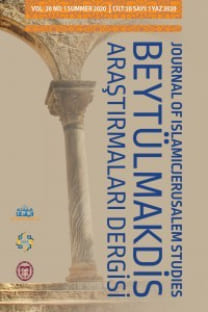Artukluların Beytülmakdis’teki Kültürel Bağlarının Pırıltıları
Artuklu Devleti çok karmaşık siyasi koşullarda Beytülmakdis’ten başlayıp Kudüs’ten Mezopotamya’ya ve özellikle Mardin ve Meyyafarikin’de hüküm sürmüş bir hanedanlıktır. Mevcut koşullarda Artukluları anlayabilmek için yeterince çalışma mevcut değildir. Bu çalışma sadece Artukluların Kudüs’le ilişkilerini ele almamaktadır aynı zamanda bu ilişkinin kültürel bağlarına da ışık tutmaktadır.
Anahtar Kelimeler:
Ribât-ı Mardini, Artuklu şamdanı, el-Salamiya Medresesi, Alimler, Kudüs
Shedding Light on the Artuqids Cultural Ties in Bayt al-Maqdis
Although the Artuqid state commenced from Bayt al-Maqdis in very complex political conditions, following which they were forced out from Jerusalem to Mesopotamia, and particularly Mardin and Mayafarqin, this is a topic that needs further research to better understand the circumstances and motives behind this. Although the Artuqids in general did not abandon their defence of the holy city, even though this would have been carried out indirectly, this study does not aim to address the political relationship between Jerusalem and this noble dynasty. Rather, it will seek to shed light on the cultural ties that existed between the Artuqid State and Bayt al-Maqdis. This topic is under-researched and has not received sufficient attention by contemporary scholars and historians. Accordingly, thebauthor hopes in this paper to try to revive this through examining these ties and clarifying the importance and value they placed on the status of Jerusalem in their conscience. In doing so, the paper will analyse an architectural and historical monument established in Jerusalem as a rare example of female architectural activity in the Holy City. It also acquires further importance and prestige since it is located only a few meters away from one of the main entrances to Al-Aqsa Mosque. This institution is also directly attributed to Mardin by name and is known as al-Ribat al-Mardini, established as a hostel for visitors who come to visit the Holy City from Mardin. In addition to this important tie, the paper will also shed light on a rare masterpiece that was brought from Mardin to al-Aqsa Mosque and still proudly adorns the Islamic Museum inside al-Aqsa Mosque to this very day. This splendid Artuqid candlestick was made for Artuq Arslan ibn Ilghazi (ruled Mardin from 1201 to 1239) and was later transferred to his son Najm al-Dunya wal-Din, Abi al-Fath, Ghazi ibn Artuq. This paper also seeks to address the architectural relations that prevailed between Jerusalem and some of the Artuqid rulers and their cities, particularly the city of Mosul, and notes that its Emir Izz al-Din Masud ibn Mawdud sent a group of sappers and stonemasons to help Ayyubid Sultan Salah al-Din in rebuilding the walls of Jerusalem.
___
- Abdul-Mahdi, A. al-Madaris fi Bayt al-Maqdis fi al-Asrayn al-Ayubi wal-Mammluk wa-Dawriha fi al-Harakah al-Fikriyah. Amman: Maktabat al-Aqsa.
- Abu Khalaf, M. (1988), Islamic Art through the Ages: Masterpieces of the Islamic Museum of al-Haram al-Sharif, Jerusalem, 1988.
- Al-Arif, A. (1961), al-Mufasal fi Tarikh al-Quds. Al-Quds: Maktabat al-Andalus.
- Al-Asali, K. (1981), Mahahid al-Ilm fi Bayt al-Maqdis. Amman.
- Al-Asali, K. (1981a), Min Atharina fi Bayt al-Maqdis. Amman.
- Bieberstein, K. and Bloedhorn, H. (1994), Jerusalem, Grundzuge der Baugeschichte vom Chalkolkithkum bis zur Fruhzeit der osmanischen Herrrschaft.3 Band, Wiesbaden 1994.
- Burgoyne, M. H. (1987), Mamluk Jerusalem an Architectural Study, Buckhurst Hill, 1987.
- Al-Dawadari, A. (1960). Kanz al-Durar wa-Jami al-Ghurar. Cairo: Matbat Lajnat al-Talif wal-Tarjamah wal-Nashir.
- Al-Hamawi, Y. (1977) Mu’jam al-Buldan. Beirut: Dar Sadir.
- Al-Hanbali, M. (1973), al-Uns al-Jalil bi-Tarikh al-Quds wal-Khalil. Amman: Maktabat al-Muhtasib.
- Hawari, M., K. (2007), Ayyubid Jerusalem (1187-1250) an architectural and archaeological study, BAR international Series 1628, Oxford, 2007.
- Ibsherli, M. & al-Tamimi (1982), Awqaf wa-Amlak al-Muslimin fi Filistin. Istanbul: IRCICA.
- Al-Isfahani, I. (1902), al-Fath al-Qusi fi al-Fath al-Qudsi. Cairo: Bulaq.
- Al-Khatib, M. Mujam al-Mustalahat wal-Alqab al-Tarikhiyah. Beirut: Mu’asaat al-Risalah.
- Al-Maqrizi, T. (1997), al-Suluk li-Marifat Duwal al-Muluk. Beirut: Dar al-Kutub al-Ilmiyah.
- Al-Maqrizi, T. (1997), Kitab al-Mawaiz wal-Itibar bithikr al-Kutat wal-Athar. Beirut: Maktabat al-Thaqafah al-Diniyah.
- Meinecke, M., Die Mamlukische Architektur In Agypten und Syrien (648/1250 bis 923-1517), Teil I, Genese, Entwicklung, Und Auswirkungen Der Mamlukischen Architektur. Teil II, Chronologische List Der Mamlukischen Baumassnahmen. Abhandlungen des Deutschen Archaologischen Instituts Kairo, 1992.
- Najim, R. & Abdul-Mahdi, A. & al-Natshah, Et. Al. Kunuz al-Quds. Amman: Mu’asasat al-Mudun al-Arabiyah.
- Al-Natshah, Y. S. (2016), al-Madrasah al-Salamiyah (al-Musuliyah) Tarikhiha wa-Imaritha wamihaj Tarmimiha. Al-Quds: Mu’asat al-Tawun.
- Al-Natshah, Y. S. (2020), al-Turath al-Mimari li-Madinat al-Quds: Dirasah fi Tatawur wa-Tarzih wa-A‘lamih wa-Anasirihi al-Mimariyah wal-Zukhrufiyah. Al-Quds: Mu’asat al-Tawun.
- Rizq, I. Mujam Mustalahat al-Imarah wal-Funun al-Islamiyah. Cairo: Maktabat Madbouli.
- Al-Safadi, S. (2000), Kitab wafi bil-Wafayat. Beirut: Dar Ihya’ al-turath al-Arabi.
- ISSN: 1367-1936
- Yayın Aralığı: Yılda 2 Sayı
- Başlangıç: 1997
- Yayıncı: Beytülmakdis Çalışmaları Vakfı
Sayıdaki Diğer Makaleler
Artukluların Beytülmakdis’teki Kültürel Bağlarının Pırıltıları
The Popular Role in Defending al-Aqsa Mosque: Ribat as a Model
Beytülmakdis Bereket Daireleri Teorisine göre Rusya'nın Suriye'deki Varlığı: Tartus Deniz Üssü
Haşhaşilerin Selahaddin Eyyubi’ye Suikast Girişimleri
Beytülmakdis Bereket Daireleri Teorisine göre Rusya'nın Suriye'deki Varlığı: Tartus Deniz Üssü
Başkan Trump’ın İsrail-Filistin Çatışmasına Yönelik Küçümseme Körükleyen Politikası
Beytülmakdis Araştırmaları Dergisi: Çeyrek Yüzyıllık Bilgi Üretimi
